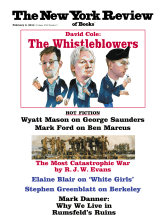In response to:
The Surprising Empress from the December 5, 2013 issue
To the Editors:
Permit me to offer two points relating to Jonathan Mirsky’s review of Jung Chang’s Empress Dowager Cixi: The Concubine Who Launched Modern China [NYR, December 5, 2013].
First, Chang is correct to say that by the end of the Qing, few Manchus still spoke the Manchu language in daily life. Use of the language was confined mainly to writing court documents. That does not mean Manchu identity had disappeared—as Mirsky points out, recent scholarship shows it had not—but by the late nineteenth century the language was not part of what made Manchus “Manchu” anymore.
Second, on sources. In the introduction to the book, Chang says that most of her materials “have never been seen or used outside the Chinese-speaking world,” and in remarks at the Hong Kong Press Club, Chang referred to “the Beijing archival material to which she unexpectedly gained access.”1 The suggestion behind these statements is that the materials used in the book represent new discoveries.
By definition, of course, a source in Chinese will be inaccessible to anyone “outside the Chinese-speaking world” unless it has been translated. Since none of the document collections she uses has been translated into English or any other language, what Chang says is true, strictly speaking. But they are far from new sources. As far as I can determine, the primary sources listed in the bibliography consist of published materials available in any major research library. The ten items listed under “First Historical Archives of China,” for instance, very frequently cited in the footnotes, are all owned by the Harvard-Yenching Library. That is to say, contrary to Chang’s suggestions, the documents that underpin her study have long been available to anyone who has been trained in Chinese history and can read Chinese.
Whether Chang was given special access to collections in the First Historical Archives is harder to say. If she was, there is little evidence of this in the book. Among the documents cited, only three are identified according to provenance in an unpublished archival holding. So there does not seem to be any reason to believe her work depends upon some previously hidden store of materials.2
As for the claim of analytical novelty, I doubt her interpretation of “Cixi the reformer” will surprise many Qing specialists. Rhoads, for one, refers to Cixi’s push for change in the dynasty’s last decade, and in her 1975 dissertation (which escaped Chang’s attention), Sue Fawn Chung also discussed the empress’s steps toward reform.3
Perhaps the most interesting angle on this book—and Mirsky points to this in his final paragraph—is that it slots neatly into the preoccupation among many intellectuals today about the parallels between the current period of reform and that of 1898–1911, when Cixi was in power. China’s leaders seem to be looking back and asking, What is the right pace for reform? How much is enough? How to avoid the fate of the Qing, which reformed itself out of existence?
Mark C. Elliott
Director
Fairbank Center for Chinese Studies
Harvard University
Cambridge, Massachusetts
Jonathan Mirsky replies:
Mr. Elliott has amplified clearly the points I was trying to make.
This Issue
February 6, 2014
The Whistleblowers
The Most Catastrophic War
On Breaking One’s Neck
-
1
Keith Bradsher, “Another Look at the Empress Dowager Cixi, This Time as the Great Modernizer,” The New York Times, October 30, 2013. ↩
-
2
This is probably also as good a place as any to correct the mistaken impression, repeated by Mirsky, that there are 12 million documents pertaining to Cixi in the Chinese archives. This is the approximate number of documents in all the Qing archives (the usual figure seen is 10 million), of which approximately one fifth are in the Manchu language. ↩
-
3
Sue Fawn Chung, “The Much-Maligned Empress Dowager: A Revisionist Study of the Empress Dowager Tz’u-Hsi in the Period 1898–1900,” University of California Berkeley Ph.D. dissertation, 1975. ↩



